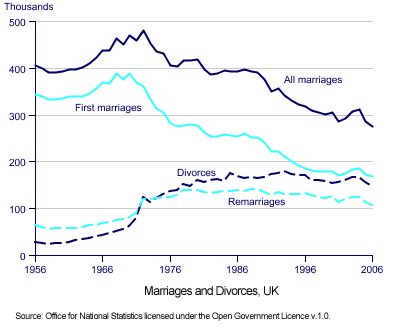 How many ways can something be described correctly?
How many ways can something be described correctly?
In IELTS Task 1 students are often required to interpret visual images such as graphs or bar charts containing data. This is something that is easy to prepare for and there are some good resources available, like this one – IELTS – The Complete Guide to Task 1 Writing]. (When I checked for the cost of this one at Amazon you could get it at about a 15% discount on the usual price.)
We’ll talk about the the range of vocabulary that can be used for these tasks in a later post. For now, though, I thought it would be helpful to show the many ways that the same features in the Marriage and Divorce Rates graph shown can be described.
Here are a variety of ways for you to describe a line graph:
- The line graph which represents the number of all marriages from 1956 to 2006 highlights an enormous decline in those 50 years from just over 400,000 at the beginning of the research to just under 300,000 by the end.
- It can be seen from the line graph showing the number of all marriages, that when the records began in 1956 approximately 400,000 people participated in marriage, the number of which then fell very sharply down to more or less 300,000 in the year 2006.
- The data given in the line graph for all marriages began with 400,000 people marrying in 1956, followed by 3 sharp peaks between 1966 and 1976, the highest peak recording a number of almost 500,000 marriages.
- In comparison, records for first marriages show a similar pattern of highs and lows , although lower in number. In 1956the figure was approximately 15% lower at 350,000 and falling markedly by 170,000 to 180,000 by the end of the chosen period. (2006)
- Conversely, there was a noticeable rise in divorces and remarriages during the same 50 year period from 1956 to 2006.
- In contrast, there was a very apparent growth in the figures for people who either divorced or remarried from 1956 to 2006. The former showing a gradual increase in the number from 1956 until 1972 (80,000 to 100,000) while the uptake in divorces levelled off during the years 1972-2006 to a fairly constant 160,000 and similar behaviour is reflected in the latter, with remarriages numbering an approximate 80,000 in 1956,and peaking at 110,000 in 1972, thereafter plateauing at more or less 110,000 until 2006.
- The line graphs highlighting the figures for divorces and remarriage emphasise a similar stability for both, especially from 1972 to 2006, recording 160,000 for divorces, while reflecting a lower fairly constant figure of 110,000 in the same period for people marrying again.
Next time I’ll show how some of these can be linked to provide the answer to an IELTS Writing Task 1 Question.
To your IELTS success,
James
P.S.
Here are more IELTS Task 1 books which you might want to investigate: IELTS – The Complete Guide to Task 1 Writing and Ielts Preparation and Practice: Reading and Writing: Academic Module (Oxford ANZ English)
P.P.S.
Fans of Elizabeth Barrett Browning’s beautiful poem about love will forgive my corruption of the title of her Sonnet 43 in the title of this post, I hope. If you haven’t read “How do I love thee?” take a while now to do that. You won’t regret it.
Sign up here if you would like to receive more information from us as soon as it is released – and get access to our free downloadable IELTS Library.
-
Downloadable Library
A Downloadable IELTS Preparation Library with advice covering all IELTS aspects
-
IELTS Test Prepcasts
Podcasts with transcripts improve Reading, Writing, Listening and Speaking
-
IELTS Test Articles
Grammar advice, sample IELTS Test questions and tips underpin learning
Free registration for access to the downloadable library and to receive notification each time we release new information, click the button to register

Hi James,
Many thanks for including my book, “IELTS – The Complete Guide to Task 1 Writing” on your site. I would like to offer your readers samples from my book. They can go to, GodivaBooks.com and then to the books section of the site where a sample is provided for download. Then IELTSPlus.wordpress.com is a very new blog where I will be adding more and more material for people from this book as well as from my new book which I am still working on.
Hi Phil,
Thanks for commenting. That’s a generous offer for readers of this site, thank you. I look forward to visiting your new blog at IELTSPlus.wordpress.com and joining in the conversation there. Let us know when your next book is ready for review and we’ll feature it here too.
Regards,
James
Hello James,
I thought you might be interested to know I have released another IELTS book –
“IELTS – The Complete Guide to Academic reading”
I think some of your readers would be interested in it.
If you are interested, I can send a few examples from the book.
Best regards,
Phil
Hi Phil,
Congratulations!. It would be great to receive extracts. Please forward them and I’ll review them here.
Regards,
James